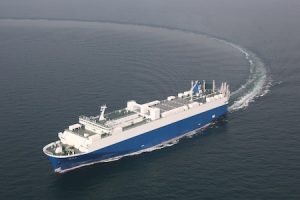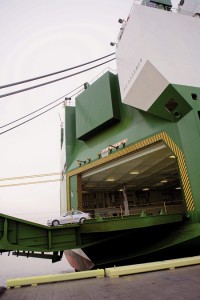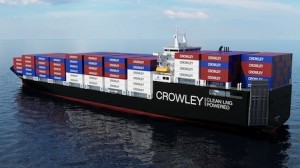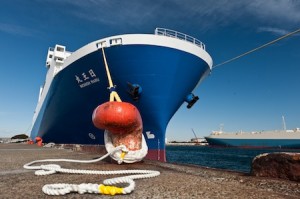With new limits on sulphur emissions coming into force for much of northern Europe and North America next year, shipping operators are trying to comply in ways as sustainable for costs as for the environment.
 Come January 1st 2015, parts of the shipping world will not be the same again. On that day, international regulations come into effect in the Baltic Sea, North Sea and English Channel, as well as the east and west coasts of North America, limiting sulphur emissions to 0.1% from the current limits of 1% in most parts of those areas.
Come January 1st 2015, parts of the shipping world will not be the same again. On that day, international regulations come into effect in the Baltic Sea, North Sea and English Channel, as well as the east and west coasts of North America, limiting sulphur emissions to 0.1% from the current limits of 1% in most parts of those areas.
The regulations were first prescribed by the International Maritime Organisation (IMO), a branch of the United Nations, and have since been transposed by the European Union. The emission control areas mark an extreme difference with much of the rest of the world (and even the rest of Europe, including the Irish Sea and the Mediterranean), where sulphur limits are currently 3.5%, and slated to come down to 0.5% by 2020 (pending a 2018 review). Limits within EU ports themselves, however, are already 0.1%.
Maritime logistics companies – including ro-ro carriers – are busy working out their compliance strategies, as the cost impact will be high. Shipping lines also face a number of uncertainties and risks, including questions over how the rules will be enforced and penalised, and whether or not enough compliant fuels will be available. In either case, many experts believe that the rising costs associated with meeting the regulations will undoubtedly result in higher transport prices to pass onto customers. There are also fears that short-sea shipping will lose market share to other transport modes.
Switchers and scrubbers
The technological challenge faced by shipowners and operators will depend on which of the three main approaches they choose to meet the new regulations. One option is to switch to marine gas oil (MGO) with lower sulphur content; another is to continue using 'traditional' high sulphur fuel oil alongside an exhaust gas cleaner, commonly known as a 'scrubber'; finally, operators can run ships on liquefied natural gas (LNG).
According to a recent survey by Denmark-based Shipping Watch, most carriers are currently moving toward the low-sulphur fuel option. This is also the case at deep-sea carrier WWL, which will bring most its vessels into compliance by 2015 with an MGO. According to Roger Strevens, vice-president for environment at the company, this fuel is already “familiar” to the industry and should have minimal technological impact. Nevertheless, Strevens adds that low- and high-sulphur fuel differ operationally, and switching between them can lead to problems if managed poorly. He stresses, however, that WWL has experience of such a switch since it has been required in Californian waters for several years.

Looking further ahead to the 0.5% global cap, Strevens says WWL has a ‘four stream approach’ that entails detailed research and testing in four potential compliance areas – distillates, other energy sources, chiefly LNG, less than 0.5% bunker [fuel] and scrubbers. "The Tarago scrubber trial is actually a part of this initiative," Strevens explains.
At this stage, the scrubber technology has not been a popular choice amongst other shipping lines largely because of its high cost, which typically runs between €1m-1.3m ($1.35m-1.8m) per vessel. There are also concerns about weight, stability and vessel compatibility. However, one significant company going the scrubber route is Copenhagen-based DFDS, which runs most of its routes in the Baltic and North Sea emission control areas. DFDS has already announced intentions to install scrubbers on 12 of its ships before the end of this year, with more installations planned for 2015. With a fleet of around 50 ships, it’s an investment that could top $100m, according to a source at the shipping line.
Cutting energy and emissions
As well as switching to low-sulphur fuel, Tom Antonissen, EU affairs adviser at the Association of European Vehicle Logistics (ECG) points out that investment in dual fuel engines – which combine normal marine fuel with LNG – is also considered a potential option for new-build ships. He warns, however, that the cost of retrofitting existing vessels is similar to installing scrubbers, while older vessels cannot be retro-fitted at all.

According to Tucker Gilliam, vice-president for special projects at Crowley, the new vessels will set a new standard for environmentally responsible shipping. The vessels, to be named El Coquí and Taíno, will operate in the trade lane between the US mainland and Puerto Rico, specifically calling the ports of Jacksonville, Florida and San Juan.
"The ships and all their systems are being designed from a holistic approach so as to maximise use of energy through the recovery of waste heat and minimise consumption or other potential energy loss sources," says Gilliam.
"As LNG technology continues to develop and become adopted as a mainstream fuel for transportation, the ability to reduce emissions of harmful greenhouse gases will present very compelling opportunities for finished vehicle shippers," he adds.
Another company eyeing shipping’s environmental impacts is Nissan Motor Car Carrier (a shipping line owned by Nissan and MOL), which launched an energy-efficient ro-ro car-carrier called the Nichioh Maru in early 2012. Akio Hinds, senior manager for product communications at Nissan explains that the company started to use the ship as part of its ‘Green Program 2016’ to reduce CO2 emission in logistics. It operates on the main maritime route in Japan between the Kanto (Oppama), Kinki (Kobe), Chugoku (Okayama) and Kyushu (Kanda) regions.
"The Nichioh Maru has installed solar power panels for the first time on a coastal ship in Japan and is propelled by an electronically controlled diesel engine. It employs LED lighting in the ship's hold and living quarters, and its hull is painted with the latest low friction coating"
- Akio Hinds, Nissan Motor Car Carrier
"The Nichioh Maru has installed solar power panels for the first time on a coastal ship in Japan and is propelled by an electronically controlled diesel engine,” he says. “It employs LED lighting in the ship's hold and living quarters, and its hull is painted with the latest low friction coating, among other energy-efficient features onboard.”
According to Hinds, the ship can reduce fuel by up to nearly 1,400 tonnes annually compared to similar-sized ro-ro ships, which is a reduction of 4,200 tonnes of CO2 emissions.
The cost impacts to come
In terms of ensuring compliance with the sulphur emission regulations, ECG’s Antonissen warns that, even though a switch from high-sulphur fuels may initially be cheaper than installing scrubbers, there is a "realistic fear” in the industry that the price of low-sulphur marine fuel could go up as much as 70% as it competes with diesel for road transport. In his view, this is largely because oil refineries, which tend to consider both fuels as almost the same product, have yet to signal any intent to boost their capacities.
“Whatever solution shipping lines will adopt, compliance will inevitably result in increased costs which will be impossible to absorb within their already low profit margins, and will ultimately lead to increased costs for their customers as well as the end consumers," says Antonissen.
"This would also correspond to what several politicians have already been saying, namely that such policies to make transport greener are wanted by the general public and therefore they should accept – even be 'educated' to pay – the costs of such measures through increased prices of the transported end products themselves,” he adds. “Obviously this is easier said than done, since in the current economic climate nobody wants to see cars becoming more expensive, for example.”
Meanwhile, from an industry perspective, Strevens warns that compliance with the current sulphur and emission regulations are already at the point where the costs cannot be absorbed, and must instead be passed on to cargo owners.
"To help ensure this is done effectively, we have been proactive in informing customers of the forthcoming regulations well in advance. In addition we are transparent in how we handle the costs," he says.
OEMs can reduce emissions further using computer technologies. A new breed of software packages such as ClassNK NAPA GREEN and the Clean Shipping Index (CSI) provide cargo owners with tools to evaluate their environmental performance.
According to Merijn Hougee, interim director at the Clean Shipping Index, the CSI takes into account CO2 emissions, sulphur and particulate matter emissions, noxious emissions, chemical products and waste water.

The final index score is the total average score multiplied with the percentage of reported ships of the total owned or managed fleet. Data can be analysed much more detailed, such as going down to the level of noxious emissions for a single engine or stern tube oil usage on a single ship.
"Instead of starting with the problem, the developers of the index started with an inventory of solutions and worked backwards. The idea to catalyse sustainable development through cargo owners arose from the influence large paper company Stora Enso has on their providers of sea transport, such as Wagenborg Shipping," says Hougee.
Companies can also join the Clean Shipping Network, which gives them access to detailed emission information of ships and carriers and enables them to compare the environmental performance of ships and shipping companies. Volvo Group Logistics Services, Volkswagen Group Logistics and Scania are already members of the network and consider the environmental data in their procurement processes.
In a recent release, Thomas Zernechel, head of Volkswagen Group Logistics, said the index would be important in identify ways to improve its shipping network. "Within the Clean Shipping Network, Volkswagen Group Logistics will intensify its efforts to ensure that ships cause lower emissions and that exhaust gases are treated," he said. "In addition, Volkswagen intends to promote the inclusion of other criteria such as the reduction of particulate emissions in the index."
According to Hougee, the programme demands that shipowners report at least 90% of their owned fleet into our database and have vessels verified by an independent third party. "Data is also used in emission reporting in order to keep track of internal reduction goals. We are currently discussing with several car companies about CSI membership," he says.
In light of the ongoing concerns about the costs of technological adaptation, Antonissen says some shipping lines have lobbied policymakers to postpone the 2015 deadline by at least two years. However, the European Commission has frequently stated that so-called ‘frontrunners’ – companies which have already invested and are seemingly ready to comply – should not be penalised for their ‘early mover’ investments by any sort of theoretical transitional measure.
Although this delay is not currently under consideration, Antonissen believes that it might be when the “true consequences” become evident in 2015. He reveals that there has also been some talk of relaxing the enforcement obligation of EU member states, largely because questions remain about how they will patrol the emission zones, given existing 0.1% sulphur limit in ports. Effectively, authorities would need to test sulphur fuel emissions out on the seas rather than only when ships are in harbour.
"Last but not least, referring to the US SECA I understand there will be a transition measure starting as of 2015, while apparently this is not possible for the EU as it needs to be requested by member states within the IMO,” says Antonissen. “This is quite ironic, as the EU keeps saying it was the US which pushed for SECAs within the IMO in the first place.”
 "Whatever solution shipping lines will adopt, compliance will inevitably result in increased costs which will be impossible to absorb within their already low profit margins, and will ultimately lead to increased costs for their customers as well as the end consumers"
"Whatever solution shipping lines will adopt, compliance will inevitably result in increased costs which will be impossible to absorb within their already low profit margins, and will ultimately lead to increased costs for their customers as well as the end consumers"- Tom Antonissen, ECG
The Commission has set up the European Sustainable Shipping Forum (ESSF) as part of a proposed 'toolbox' of measures meant to support the shipping sector. However, according to Antonissen many stakeholders believe this toolbox is empty as it lacks the necessary funding.

"There are also currently discussions going on both at IMO and EU-level with regards to potential new measures to further restrict [the] NOX and CO2 emissions of shipping. We can only hope that the regulators will learn the right lessons and come up with more realistic future policies that take the situation of all stakeholders into account," he adds.
WWL’s Strevens calls for tougher enforcement, particularly in Europe, to ensure the playing field is as level as possible. "In order for the serious, quality players to be able to compete on fair terms, there must be a robust enforcement regime,” he says. “In Europe enforcement is generally poor and so I think correcting that deficit is one of the main areas that the EC and other authorities could address to help the responsible vehicle shipping sector, as well as the environment and costal populations.”
*Read more at ECG’s latest report on sulphur content in marine fuels, as well as other related position papers.

























![Global[1]](https://d3n5uof8vony13.cloudfront.net/Pictures/web/a/d/s/global1_726550.svgz)









